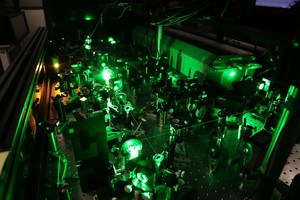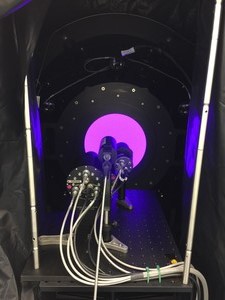GLAMR: Goddard Laser for Absolute Measurement of Radiance
The Goddard Laser for Absolute Measurement of Radiance (GLAMR) laboratory at Goddard Space Flight Center (GSFC) is a state-of-the-art spectral and radiometric sensor characterization facility. The work is based on the calibration methodology developed by National Institute of Standards and Technology (NIST) called Spectral Irradiance and Radiance Calibration using Uniform Sources (SIRCUS) . The primary objective of GLAMR is to transfer the advanced calibration technique of SIRCUS into an operational facility to make it better available for characterization of airborne and satellite sensors.
Traditional spectral and radiometric sensor characterization is typically accomplished with two distinct measurement steps: spectral scan using a collimated monochromator output for spectral characterization and measurement of a white-light integrating sphere for absolute radiometry. Limitations of the spectral characterization include: the collimated monochromator output can only reasonably characterize a small portion of the sensor’s focal plane; relatively wide bandwidth of monochromator output limits fidelity, and relatively large uncertainty of the monochromators spectral position compromise spectral knowledge. GLAMR combines spectral and radiometric characterization into one measurement sweep by creating a monochromatic extended source. This means that the monochromatic laser sources of GLAMR illuminate an integrating sphere with a large exit port which can fill the full aperture and field of view of most sensors. Spectral position of the light can be measured with tens-of-picometer accuracy and the output radiance can be measured to accuracies approaching 0.5% or better.
The GLAMR laser technology
Transfer of radiometric traceability
GLAMR is the light source
GLAMR is the light source enabling the transfer of the radiometric traceability of NIST’s POWR to the airborne/satellite sensor to via the transfer radiometers and sphere monitors. These efforts make use of several laser systems developed in the GSFC’s GLAMR Laboratory. GLAMR has characterized sensors including
- Visible Infrared Imaging Radiometer Suite (VIIRS) on Joint Polar Satellite System-2 (JPSS-2)
- JPSS-3 VIIRS
- JPSS-4 VIIRS
- Landsat-9 Operational Land Imager (OLI)
- Lucy L'Ralph Multispectral Visible Imaging Camera (MVIC)
- Plankton, Aerosol, Cloud, ocean Ecosystem (PACE) Ocean Color Instrument (OCI)
- Research Scanning Polarimeter (RSP)
- Goddard's LiDAR, Hyperspectral & Thermal Imager (G-LiHT)
- Pandora
- AirHARP-2
- PICARD
The GLAMR team composed of NASA and NIST personnel received the NASA Agency Group Achievement award in 2017 for “outstanding contribution to NASA’s excellence in sensor characterization to enable climate-level measurement accuracy.” Drs. McCorkel (NASA), Brown (NIST), Woodward (NIST), and McAndrew (NASA) also received a patent for this calibration methodology on June 13, 2017. The GLAMR team was awarded the 2019 NASA Silver Achievement Medal for the Landsat-9 OLI-2 characterization.




